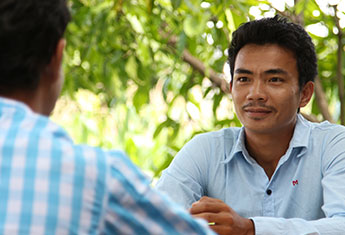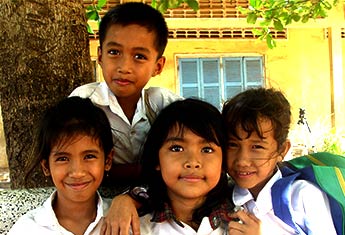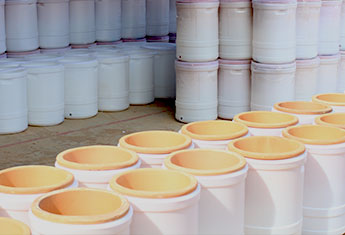A: Yes. Government officials from other nearby countries have recognized the unique approach that RDI has used and have formally requested that we help implement similar strategies in their respective countries. Myanmar, Laos and Indonesia are among those who have expressed interest. Myanmar is the first to begin implementation of specific RDI strategies.
- No 50A, Phum Prek Thom Sangkat Kbal Koh, Khan Chbar Ampov
- 855 (0)12-200-235
- info@rdic.org

FAQ
GENERAL
Q: What do you mean by "appropriate technologies"?
A: In some cases a solution to a problem may not be practical. It may not be culturally appropriate. It may not be feasible to use for poorly educated person. It may fix the problem, but not in a sustainable way. For instance if a man complains of chronic headaches, we do not give him a bottle of Tylenol™. While this may cure the problem, it is only temporary. Hydration is a huge problem in Cambodia. The ongoing cure for the man’s headache would most likely be to teach him to drink plenty of clean filtered water everyday instead. In the same way, though a fancy water filter may clean huge amounts of water very quickly, if the filter can not be purchased for a reasonable amount of money, or the materials to build the filter cannot be found locally it is of little good. Furthermore, if the users of the filter do not understand how germs work they may re-contaminate the water supply or fail to use the filter properly during operation. Education level, sustainability of the technology, and the ability to produce technology locally and cheaply MUST be considered when curing the CAUSE of problems, not just treating the EFFECTS of the problem. In this way, RDI is here for the long run, refusing to apply temporary “quick fixes” to problems that are perpetual. As a result, RDI is committed to “appropriate” solutions to complicated problems.
Q: Where does your funding come from?
A: Our American staff salary is paid through the donations of a large non-profit organization in the USA. Project funding, khmer staff salary, and daily operating costs are paid for by donations from cooperating international organizations and by private donations by individuals.
Q: Do you have more information if I am thinking about visiting Cambodia and specifically staying with RDI?
A: We sure do! There is all kinds of info on our visitors page and we have a “what to expect page” and also a document detailing expenses for visiting teams. All are helpful if you are coming out to stay with us at RDI.

EDUCATION
Q: How many schools have you worked in?
A: Since 1998, RDI has done educational presentations in 26 schools. This means that over 20,000 Khmer students have personally participated in the RDI educational program.
Q: Wow, really? How many schools are still waiting for RDI to come to?
A: In this district alone, there are approximately 40 more schools that have officially requested the presence of RDI. The government of Cambodia has officially requested our presence in all 16,000+ schools in the country. District leaders have also put in additional requests. Of course the vision of RDI includes striving to meet these requests but funds and staff currently make this impossible.
Q: Who actually performed these school presentations?
A: Our own RDI staff has performed about half of the presentations. However, the other half were performed by volunteers (like yourself) who visited Cambodia for short term trips. (With the help of local translators from the RDI staff.) Currently, more and more presentations are done by volunteers. The more volunteers that come, the more school children throughout the country will receive this vital presentation.

CLAY POT / WATER FILTRATION
Q: So, why does this work? How are germs killed in this ceramic pot?
A: Two processes are at work. Because the mixture of rice and clay produce small micropores, parasites, amoebas, and large bacteria cannot flow through due to mechanical processes. Simply put, water can fit through the pores, most disease causing organisms cannot. The coating of colloidal silver adds a chemical process to stop other bacteria. Together, this system eliminates 98% of the harmful diseases present in surface water.
Q: How long does this filter last?
A: A study was done at MIT that showed that the filter maintained its effectiveness for over one year, however testing was stopped after one year. It is estimated that the filter will last with repeated daily use long after one year.
Q: How does the ceramic pot become so porous?
A: Ceramics are inherently porous. Our specialized process of firing the clay and rice husk mixture causes the rice husks to completely burn away in the intense heat of the kiln. When the rice husks burn out of the mixture, micropores remain in the newly created ceramic filter which allow for a perfect seepage of water minus the harmful microbes that once infected it.
Q: What maintenance does the ceramic filter require?
A: If the water is turbid or cloudy or has a lot of solids in it then it needs to be periodically cleaned with a soft bristle brush. RDI recommends a monthly cleaning unless visual buildup of solids is identified. Solids such as leaves or other biomass from a highly contaminated source should be cleaned more frequently.
Q: How do you know that it works in the village? Do families really use this?
A: Part of the commitment RDI has for maintaining a its community focus for sustainable change is to insure the viability of the filters. The filters are tracked, and periodically RDI goes back to the community and runs tests on the filters to verify that the filters are still giving families safe, pure drinking water. Projects at RDI are ONGOING, we cherish the opportunity to impact the lives of families. If something is working, we test it later to make sure it is still working. If a project is NOT working we look for new solutions.

MEDIA / KARAOKE
Q: How does Karaoke production work? Why do you do it?
A: First, Karaoke as an activity in Cambodia bares little resemblance to the American style of karaoke. As opposed to the USA where karaoke is mainly a bar-room activity that enjoys only mild popularity overall, in Cambodia virtually everyone likes to participate. Entire families sing along in their homes. Karaoke is sung at large celebrations and parties, small restaurants, and even in outdoor parks. It also does NOT require an audience. While in the western world, karaoke tends to be a ‘performance’ activity, in many Asian cultures it is not. Also, every age group participates with equal enthusiasm.
Secondly, karaoke songs need not be hit songs to be popular in Khmer culture. The style of the song and the lyrical method is what makes particular songs enjoyable. Our Khmer staff is very skilled at crafting particular lyrics and stylistically attractive songs that most any Cambodian would enjoy singing. RDI also employs nationally recognized musicians and singers to provide the back-up music and vocals for the initial recording.
While Americans might find an educational song to be “cheesy” or less than desirable, RDI has found that audiences are EAGER to sing our educational songs because of the very high quality in which they are written, played, and vocalized. Adults and children actually will pick up a microphone and begin singing brand new songs they have never heard because of the familiar way the songs are produced. In numerous field tests Cambodians are excited to sing along with no prompting. This is truly a culturally appropriate method of combining education with popular entertainment.
Q. How can Karaoke be used to teach?
A: Here is one example. When the RDI karaoke truck went on a field test with a volunteer group to check on water quality in a rural village, an interesting thing occurred. A crowd gathered around the truck. When the karaoke video CD was played, villagers clamored for the microphone. Instantly, children were singing along to the songs. While this may not seem to unusual, it must be noted that the karaoke songs were newly recorded RDI written songs about arsenic. The song had never been heard before, yet by the time the RDI team left that day, the informative songs were being sung by memory by various villagers. Furthermore, upon a return visit days later it was discovered that some villagers had actually already ACTED on the instructions in the song. Karaoke is without a doubt and effective way of communicating much more than just love songs. It can and does teach valuable and important information as well.
